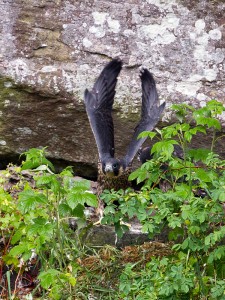The eyasses have…… fledged?

After much activity, at 6:22 am one chick (with the paler forehead) ran along the nest ledge and using a mixture of flapping and climbing, was able to move to the next ledge upwards from the eyrie. The other chick (with a darker forehead) was busy feeding on the remains of the carcass it stored yesterday, but looked up and watched the activity of its sister closely. At 6:36 am it copied the behaviour and joined the other eyas on the higher ledge.
Throughout the day the adventurous pair moved slowly higher up. Eventually at 2 pm they, were in the tree that hangs down the cliff face (unfortunately out of view of our webcam, so apologies for this!).
The adult falcon appeared to be encouraging them to fly by taking food across to them, but quickly leaving (with the meat) and flying back to this side of the gorge. Much flapping ensued, but the eyasses remained in the branches. The mother must have realised that the time for them to fly was not quite here yet, so she took food to the chicks.
Unfortunately the tiercel seemed a bit more uneasy with the situation. He appeared with a starling at the nest and was looking round to see where the young falcons had gone. He seemed to look up towards them, but then continued to store the carcass in the larder. He just can’t of been sure what to do in this situation, in this pair it seems to be the falcon who does the parenting! One visitor suggested he may just be going a bit senile in his old age! He is, however now up 34 fledged chicks in his life time, 23 of which with his current falcon. So not bad going….
The definition of fledging seems to differ with species and authority! Some claim it is when the chicks are able to fly, or at least have flight muscles of the correct size. Others say that fledging is when the young leave the nest site. In a lot of species a bird that has fledged is still dependant on its parents for food. I think in this case we shall call them fledglings, which can’t quite fly yet!
Tom Wells – Peregrine Protection Officer
Help protect Scotland’s wildlife
Our work to save Scotland’s wildlife is made possible thanks to the generosity of our members and supporters.
Join today from just £3 a month to help protect the species you love.
Preface
After much activity, at 6:22 am one chick (with the paler forehead) ran along the nest ledge and using a mixture of flapping and climbing, was able to move to …
